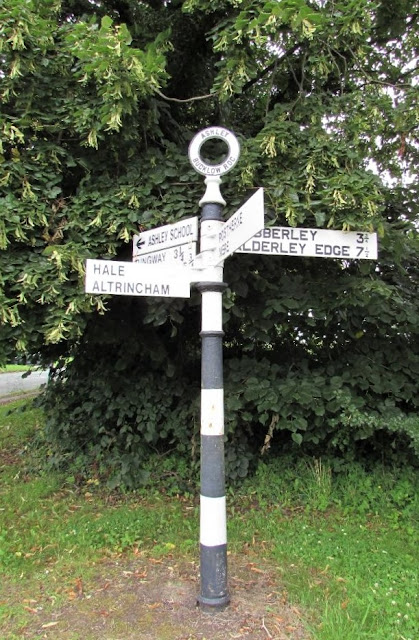Founded in 1881 as “The Manchester Theological College” and renamed in 1906 in honour of Sir William Pickles Hartley, of “Hartley’s Jams” fame, who was among the church's most prominent benefactors; Hartley College was an institute for the training of ministers for the Primitive Methodist Church.
 |
| Hartley (Primitive Methodist) Training College,1924 |
Two of the college’s earliest Principals moved to addresses in Chorlton-cum-Hardy on their retirement.
Rev. James Macpherson
Rev. James Macpherson was the Principal of “The Manchester Theological College” for the first eight years of its life (1881-1889).
He also edited the Primitive Methodist’s Magazine - “The Connexional” from 1871 until 1876, during which time, in 1872, he was elected President of the Primitive Methodist Conference.
He was born, in Edinburgh, in 1814. In the September quarter of 1839, he married Fanny Bishop Buck in Weymouth, Dorset. The couple produced five children, Christian, Archibald, Sophia, Jessie, and George. All five children were born in the North-West of England; the first three in Rochdale, Jessie near Chester and George in Haslingden, Lancashire.
The geographical range of the civil records of this family does, however, indicate the typical lifestyle of a Methodist minister who would rarely be attached to the same church/chapel for more than a couple of years. In the March quarter 1858, his wife, Fanny, died in Blackburn, Lancashire at the age of just 48. Just over three years later in the September quarter of 1861 he re-married, also in Blackburn, Mary Jane Aspinall.
Rev. Macpherson’s daughter, Christian, moved to live in Edinburgh, Scotland where she met Duncan Kennedy, a joiner and builder, who she married in Partick, nr. Glasgow on 13th February, 1873. Later his daughter and her husband returned to Lancashire and settled in the Cheetham area of Manchester.
Rev. Macpherson had by this time acquired a row of houses on Cluny Street, Cheetham one of which was already occupied by his son George with his wife and family. Duncan and Christian moved into an adjoining property with Rev. MacPherson appointing Duncan Kennedy as his agent for the remaining properties.
Shortly after the loss of his second wife, who died in South Manchester, during the March quarter of 1888, and his retirement from his post as Principal, Rev. Macpherson continued his ministry in South Manchester living initially at 30, Meadow Street, Moss Side, with his two unmarried daughters, his son and three grandchildren. He spent the final seven years of his life in Chorlton-cum-Hardy, first renting a house at 27, Albany Road from 1894 until 1896. Then in 1897 the rate book shows him as the owner occupier of 23, High Lane, a large newly-built house of 10 rooms, where at the 1901 census he was still living with his single daughters Jessie and Sophia, his widowed daughter Christian Kennedy, and his son George. Adjacent to this new property which he named “Cluny Cottage” there commenced the development of new buildings for the Primitive Methodist Church.
 |
| Macpherson Memorial (Primitive Methodist) Church 1959, High Lane |
A school / church hall was built in 1896 followed by a church, with services taking place from 1898 and opened fully on the 20th September, 1902. As Rev. Macpherson had by this time passed away at his home on 18th April, 1901 the new church was given the name of “The Macpherson Memorial”
As of 1900 the Manchester rate books show Rev. Macpherson’s Cluny Street properties alone providing an approximate rental income of upwards of £350. Given this large income his naming of his family home “Cluny Cottage” and the new church being named after him it is perhaps, not too conjectural to conclude that both “Cluny Cottage” and adjacent Primitive Methodist structures were all financed from the Cheetham property portfolio. What can be said for definite is that, in December, 1902, the final sworn assessment of his estate, for probate purposes, was £8,214-1s-0d or just over £1,000,000 at today’s value.
Rev. William Jones Davies
Rev. William Jones Davies was for five years from 1908 until 1913 the principal of the renamed Hartley College on Alexandra Road, Whalley Range, Manchester.
Rev. Davies was born in 1851 in Lydham, on the Shropshire/Montgomeryshire, England/Wales border. His parents were Edward, a farmer and Martha (née Jones). William’s younger brother, Edward Robinson, was also a Primitive Methodist minister. Rev. Davies married Emily Jane Bradford in the June quarter of 1883 while he was stationed at Cradley Heath, South Staffordshire.
The couple had seven children including one set of twins, George Denis and Mary Christine, born in the September quarter of 1888 in the Clun district of Shropshire. Sadly, Mary Christine was to die tragically young at just 12 years old while Rev. Davies was serving as a minister in Grimsby, Lincolnshire. Of his other children; one of his remaining daughters, Dorothy Llewella, became a student at Manchester University and he would have witnessed her degree ceremony at the University’s Whitworth Hall on 3rd July, 1915 when she was awarded an Honours Degree of Bachelor of Arts (Class 2:1) in History. His first born, William Claud Howard, followed him into the Primitive Methodist ministry who after his father’s death in 1916 left the Primitive Methodist Church and later became a minister in the Presbyterian Church.
In retirement, Rev. William Jones Davies lived at 6, Oak Avenue, Chorlton-cum-Hardy, Manchester, where he died on the 21st June, 1916.
 |
| 6 Oak Avenue, 2020 |
Rev John Bedford
Rev. John Bedford, a one-time President of the Wesleyan Conference (1868-69), passed away in the early hours of the 20th November, 1879 at his home, 18, Whitelow Road, Chorlton-cum-Hardy.
He was born on 27th July, 1810 in Wakefield, Yorkshire (West Riding). His father, also named John, died when he was only five years old. After initially working in a solicitor’s office, in Leeds, he became a full-time minister of the Wesleyan Methodist Church in Glasgow, Scotland in 1831. Shortly after becoming a minister he met Maria Gledhill who he married in 1835 and with whom he had two surviving sons William Henry born in Bolton, Lancashire in the December quarter of 1842 and Frederick Samuel who was born in Birmingham in the December quarter of 1850.
From, 1860 his increasing rôle in the administrative affairs of the Wesleyan conference necessitated his permanent residence in the Manchester area. In this year, 1860, he was appointed to the general chapel committee and soon rose to the position of being its secretary. At the church’s conference in Bristol in 1867, Rev. Bedford was elected to serve as its President for the following year.
Rev. Bedford first settled in the Chorlton-on-Medlock district of Manchester, where he resided for over a decade at 18, Acomb Street before around the time of his semi-retirement from his Secretarial work for the “Conference” he made the move to Chorlton-cum-Hardy.
According to the rate books of the Chorlton-cum-Hardy township this was, from the 6th September, 1872, at Wilton Street, Chorlton-cum-Hardy, where a near neighbour was a young Church of England clergyman; Rev. Hugh Bethell Jones. Somewhat unusually for that time there is some evidence that the two men were on very friendly terms. When in March, 1876 a subscription was raised to present Rev. Bethell Jones with a gift to mark his departure from St. Clement’s, on his appointment to the rectorship of St John the Devine’s, Brooklands, Cheshire, Rev. Bedford contributed one guinea to the collection. Although he was too indisposed to attend the presentation to his fellow cleric at the National School on Chorlton Green on 23rd March, 1876 he did send a very glowing testimonial which was read out at the ceremony and transcribed in the report of the event in the “Manchester Courier and Lancashire General Advertiser” on the 25th March, 1876.
 |
| 40 Whitelow Road, 2020 |
Although Rev. Bedford died in 1879, his widow, Maria, and son, Frederick Samuel, continued to live on Whitelow Road. Maria died in the December quarter of 1888. Frederick Samuel and his family continued to live on Whitelow Road, however, and at some stage they had moved to number 40 (Although this was possibly due to the houses on Whitelow Road being re-numbered following a new housing development). Even after Frederick Samuel passed away in the March quarter of 1909 his widow Mary Jane remained in the house; she was still recorded living at 40, Whitelow Road in Kelly’s 1933 Directory of Lancashire, Manchester, Salford & Suburbs. In the meantime, two of Rev. Bedford’s grand-daughters Nellie, in 1921, and Ethel Mary in 1922, had held their weddings in the Methodist Church on Manchester Road. Throughout the First World War, Ethel Mary had served as a volunteer of the British Red Cross and in the kitchens and later as a nurse in two of the Red Cross Hospitals in Chorlton-cum-Hardy. One was at a building she would have been very familiar with; the Manchester Road Methodist Sunday School. The other was the Baptist’s Sunday School on Wilbraham Road.
Location; Chorlton
Pictures;
Hartley (Primitive Methodist) Training College (1924)
m 68658 (Unknown), Macpherson Memorial (Primitive Methodist) Church 1959, High Lane, Chorlton-cum-Hardy, m 17904 A.E.Landers, courtesy of Manchester Libraries, Information and Archives, Manchester City Council,
http://images.manchester.gov.uk/index.php?session=pass
6, Oak Avenue, 2020, 40, Whitelow Road 2020
Tony Goulding, © 2020
Sources
I would like to acknowledge a good source of data "My Primitive Methodists" website
E-mail address:-
enquiries@englesbrook.org.uk






















.jpg)
.jpg)
.jpg)
.jpg)
























